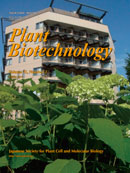Volume 31, Issue 2
Displaying 1-14 of 14 articles from this issue
- |<
- <
- 1
- >
- >|
Original Papers
-
Article type: Original Paper
2014 Volume 31 Issue 2 Pages 89-96
Published: June 25, 2014
Released on J-STAGE: June 28, 2014
Advance online publication: March 26, 2014Download PDF (3052K) -
Article type: Original Paper
2014 Volume 31 Issue 2 Pages 97-104
Published: June 25, 2014
Released on J-STAGE: June 28, 2014
Advance online publication: March 15, 2014Download PDF (6425K) -
Article type: Original Paper
2014 Volume 31 Issue 2 Pages 105-114
Published: June 25, 2014
Released on J-STAGE: June 28, 2014
Advance online publication: March 28, 2014Download PDF (884K) -
Article type: Original Paper
2014 Volume 31 Issue 2 Pages 115-121
Published: June 25, 2014
Released on J-STAGE: June 28, 2014
Advance online publication: May 24, 2014Download PDF (6237K) -
Article type: Original Paper
2014 Volume 31 Issue 2 Pages 123-132
Published: June 25, 2014
Released on J-STAGE: June 28, 2014
Advance online publication: March 20, 2014Download PDF (14626K) -
Article type: Original Paper
2014 Volume 31 Issue 2 Pages 133-139
Published: June 25, 2014
Released on J-STAGE: June 28, 2014
Advance online publication: May 24, 2014Download PDF (1084K) -
Article type: Original Paper
2014 Volume 31 Issue 2 Pages 141-147
Published: June 25, 2014
Released on J-STAGE: June 28, 2014
Advance online publication: March 26, 2014Download PDF (1816K) -
Article type: Original Paper
2014 Volume 31 Issue 2 Pages 149-158
Published: June 25, 2014
Released on J-STAGE: June 28, 2014
Advance online publication: May 28, 2014Download PDF (8580K) -
Article type: Original Paper
2014 Volume 31 Issue 2 Pages 159-165
Published: June 25, 2014
Released on J-STAGE: June 28, 2014
Advance online publication: May 02, 2014Download PDF (2315K)
Short Communications
-
Article type: Short Communication
2014 Volume 31 Issue 2 Pages 167-172
Published: June 25, 2014
Released on J-STAGE: June 28, 2014
Advance online publication: March 15, 2014Download PDF (6550K) -
Article type: Short Communication
2014 Volume 31 Issue 2 Pages 173-178
Published: June 25, 2014
Released on J-STAGE: June 28, 2014
Advance online publication: March 20, 2014Download PDF (1708K) -
Article type: Short Communication
2014 Volume 31 Issue 2 Pages 179-183
Published: June 25, 2014
Released on J-STAGE: June 28, 2014
Advance online publication: April 04, 2014Download PDF (8560K)
Notes
-
Article type: Note
2014 Volume 31 Issue 2 Pages 185-190
Published: June 25, 2014
Released on J-STAGE: June 28, 2014
Advance online publication: May 10, 2014Download PDF (3248K) -
Article type: Note
2014 Volume 31 Issue 2 Pages 191-194
Published: June 25, 2014
Released on J-STAGE: June 28, 2014
Advance online publication: March 14, 2014Download PDF (295K)
- |<
- <
- 1
- >
- >|
